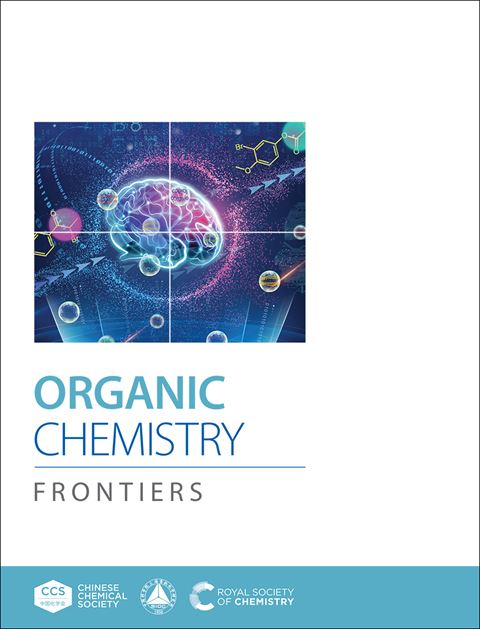揭示各种金属盐通过叔丁基过氧化氢(TBHP)产生的过氧自由基氧化环己烯的不同途径
IF 4.6
1区 化学
Q1 CHEMISTRY, ORGANIC
引用次数: 0
摘要
环己烯具有烯丙基 C-H 键和 C=C 键两个反应中心,因此选择性氧化环己烯具有相当大的挑战性。通过调节催化系统实现对这两个反应中心的高选择性氧化意义重大。在此,我们分别使用 CuCl2 和 VCl3 作为催化剂,在叔丁基过氧化氢(TBHP)存在下,实现了对环己烯烯丙基 C-H 键和 C=C 键反应位点的选择性氧化。CuCl2 催化的环己烯氧化反应主要产生烯丙基位的氧化产物,而 VCl3 催化的环己烯氧化反应主要产生 C=C 键的环氧化产物。两种不同的反应机理主要是由于 t-BuOO- 自由基在各自催化体系中的作用不同。通过 EPR(电子顺磁共振)表征可知,CuCl2 催化体系中 t-BuOO- 自由基的数量远低于 VCl3 体系。通过 18O2 实验、KIE 动力学和 EPR,提出了两种不同的机理。结果表明,CuCl2 催化剂能迅速生成 t-BuOO- 自由基,该自由基经过双分子衰变生成 O2。氧气与环己烯的烯丙基自由基结合,在烯丙基反应中心生成氧化产物。相反,VCl3 催化剂促进了 t-BuOO- 自由基的生成,该自由基与环己烯的 C=C 键反应,直接生成环氧化物。本文章由计算机程序翻译,如有差异,请以英文原文为准。
Unravelling the different pathways of cyclohexene oxidation via peroxyl radical generated from tert-butyl hydroperoxide (TBHP) by various metal salts
The selective oxidation of cyclohexene is rather challenging due to its allylic C-H and C=C bond two reactive centers. It is great significant to achieve highly selective oxidation towards the two reactive centers through regulating catalytic system. Herein, the selective oxidation towards allylic C-H and C=C bond reactive sites of cyclohexene was achieved by using CuCl2 and VCl3 as catalyst respectively in the presence of tert-butyl hydroperoxide (TBHP). CuCl2-catalyzed oxidation of cyclohexene mainly yielded oxidation products at allylic position, while VCl3-catalyzed oxidation of cyclohexene mainly yielded epoxidation products at C=C bond. The two different reaction mechanisms are mainly due to the different roles of t-BuOO• radical in the respective catalytic systems. From EPR (Electron Paramagnetic Resonance) characterizations, it could be known that the amount of t-BuOO• radicals in the CuCl2 catalytic system is much lower than that of in the VCl3 system. The two different mechanisms were proposed by means of 18O2 experiments, KIE kinetic and EPR. It revealed that CuCl2 catalyst could rapidly generate the t-BuOO• radical, which undergoes a bimolecular decay to produce O2. The oxygen combines with the allyl radical of cyclohexene to produce the oxidized product at allylic reactive center. In contrast, VCl3 catalyst promoted the generation of t-BuOO• radical, which reacted with C=C bond of cyclohexene to yield epoxide directly.
求助全文
通过发布文献求助,成功后即可免费获取论文全文。
去求助
来源期刊

Organic Chemistry Frontiers
CHEMISTRY, ORGANIC-
CiteScore
7.90
自引率
11.10%
发文量
686
审稿时长
1 months
期刊介绍:
Organic Chemistry Frontiers is an esteemed journal that publishes high-quality research across the field of organic chemistry. It places a significant emphasis on studies that contribute substantially to the field by introducing new or significantly improved protocols and methodologies. The journal covers a wide array of topics which include, but are not limited to, organic synthesis, the development of synthetic methodologies, catalysis, natural products, functional organic materials, supramolecular and macromolecular chemistry, as well as physical and computational organic chemistry.
 求助内容:
求助内容: 应助结果提醒方式:
应助结果提醒方式:


